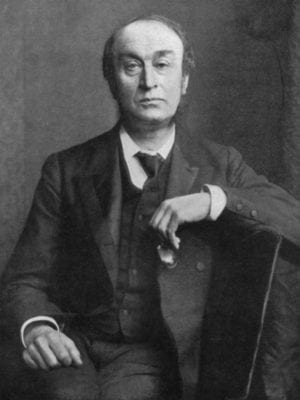Sydney Ringer
Sydney Ringer (1835-1910) was a British clinician, physiologist and pharmacologist. Best known for his extensive work on inorganic salt solutions and the effect on the heart.
Ringer was born in Norwich, East Anglia. He was first exposed to medicine whilst shadowing a local Doctor. Ringer was able to attend medical school through the generous financial support of friends and family. He obtained a bachelor in medicine in 1860 and went onto achieve a Doctor of medicine in 1863. He went on to be an assistant physician at the University College Hospital, also working at Great Ormond-street.
Ringer was a very quiet and reserved man in private life having little time for social activities. His lifestyle was ‘early to bed and early to rise‘ and much of his scientific work was done in the mornings before commencement of his clinical duties.
His career focused on clinical medicine, where he built a reputation as a great diagnostician. Although clinical medicine was his career, scientific experiments were his hobby. He was known for only testing theories he could confirm or reject and as one of the first scientific clinical pharmacologists.
Ringer noted that a solution perfusing a frog’s heart must contain sodium, potassium and calcium salts in a definite proportion if the heart is to be kept beating.
Ringer’s ‘discovery’ of his solution (Ringer’s solution) arose after his lab assistant mistakenly substituted tap water from the New River Water Co. for distilled water whilst experimenting on frog hearts. The replaced water had a calcium concentration 38.3 PPM ~1M.
In 1932, Alexis Frank Hartmann modified Ringer’s solution by adding sodium lactate to it with the idea of combating acidosis in his young patients. In Britain, the modification is called Hartmann’s solution after the American Hartmann; in America it is called Ringer’s Lactate after the Englishman, Sydney Ringer
Biography
- Born on March 11, 1835 in Norwich, England. His father died young, leaving his mother to bring up their three sons
- 1854 – With the generous help of friends and relatives, he began his formal medical studies at University College, London
- 1860 – Bachelor of Medicine (MB) from University College Hospital, London
- 1861-1910 Spent his entire career associated with University College and its hospital, initially as a resident medical officer(1861), assistant physician (1864), full physician (1866), and emeritus physician (1900)
- 1863 – Doctor of Medicine and MRCP (Membership of the Royal College of Physicians)
- 1864-1869 Assistant physician at the Children’s Hospital at Great Ormond Street.
- 1869-1897 Published A Handbook of Therapeutics which ran through 14 editions and was translated into 10 languages
- 1870 – Elected Fellow of the Royal College of Physicians of London (FRCP)
- 1882 – ‘Discovery’ of Ringer’s solution
- 1877-1890 Holme professor of clinical medicine
- 1889 – Elected to Fellowship of the Royal Society (FRS)
- 1900 – Retired; elected physician emeritus to UCH
- Died on October 14, 1910 from a cerebrovascular lesion, aged 75 in Lastingham, North Yorkshire, England
Medical Eponyms
Ringers Solution (1882)
Solution of salts dissolved in water to create an isotonic solution relative to the body fluids of an animal.
Ringer studied the effects of electrolytes on cardiac and involuntary muscles. In particular the actions of various inorganic salts on the behaviour of the heart.
The discovery of Ringers solution was an accident. Ringer’s lab assistant mistakenly substituted tap water for distilled water, in experiments they were performing on frogs hearts. Ringer noticed that the experiments with tap water yielded different results from those with distilled water; he deduced this was due to the fact tap water contained inorganic substances.
I discovered, that the saline solution which I had used had not been prepared with distilled water, but with pipe water supplied by the New River Water Company. As this water contains minute traces of various inorganic substances, I at once tested the action of saline solution made with distilled water and I found that I did not get the effects described in the paper referred to. It is obvious therefore, that the effects I had obtained are due to some of the inorganic constituents of the pipe water
Ringer 1883
Ringer tested a variety of solutions with different amounts of salts and tested the effect this had on maintaining contractions in isolated frog hearts. He noted that saline alone or saline with potassium chloride and sodium bicarbonate did not maintain contractions. When calcium was added contractions were maintained, however the amount of calcium needed to be in the correct proportions to potassium.
This helped show that different electrolytes have antagonistic properties to those in other groups. It also showed that sodium/potassium/chloride/calcium in certain concentrations and proportions were essential for protoplasmic function. Ringers solution was developed as a result of these experiments; this solution allowed tissues/organisms to survive in outside of blood so they could be experimented on.
The ability of a small volume of Ringer solution to sustain an excised frog heart-nerve preparation enabled Otto Loewi and Sir Henry Hallett Dale to propose the chemical transmission of nerve impulses For this, Loewi and Dale received the 1936 Nobel Prize in Physiology or Medicine.
A mixture containing 100cc saline [0.75% NaCl], 5cc sodium bicarbonate [0.5%], 5cc calcium chloride [1 in 1082, i.e. approximately 0.1% Ca], with 1 cc potassium chloride [1%] makes an excellent artificial circulating fluid, for with this mixture the heart will continue beating perfectly.
Ringer 1883
The exact constitution of Ringer’s solution varies slightly around the world but it is essentially an isotonic solution containing 8 mg of sodium chloride, 0.3 g of potassium chloride, and 0.33 g of calcium chloride in 1 litre of distilled water. This solution equates to approximately (mmol/l): total Na 133, KCl 1.34, NaHCO3 2.76 and CaCl2 1.25, a ‘recipe’ hardly bettered since.
Many modifications have been suggested, each with a specific purpose in mind. The Ringer-Locke solution contains sodium bicarbonate and glucose.
Ringer’s Lactate (1932)
Alexis Frank Hartmann modified Ringer’s solution by adding sodium lactate to it with the idea of combating acidosis in paediatric diabetic patients.
The Sydney Ringer Lecture (1912)
In 1912, Ringer’s only surviving daughter, Mrs Kayler, endowed a biennial lecture to be given at University College Hospital. The subject of the lectures was to be on research in medical science, carried out within the laboratories of the College or Hospital.
Sydney Ringer lecturers incude T.R. Elliott, William Bayliss, Thomas Lewis, Charles Harrington, Peter Medawar, and Bernard Katz.
Key Medical Attributions:
Effect of anaesthetics on the circulation
Ringer was one of the earliest investigators of the effects of anaesthetics on involuntary and cardiac muscle and on the circulation. He was associated in this work at one time with Dudley Wilmot Buxton (1855-1931), a young colleague who later became an anaesthetist on the staff of UCH.
Ringer and Buxton showed that the vitality of involuntary muscle in the frog persists longer following ether than after chloroform
Major Publications
- Ringer S. On the Alteration of the Pitch of Sound by Conduction through Different Media. Proceedings of the Royal Society of London, 1859
- Ringer S. On the temperature of the body as a means of diagnosis in phthisis (tuberculosis). London : Walton and Maberly 1865.
- Ringer S. A handbook of therapeutics 1e. London 1869 [12e 1888].
- Ringer S. On the antagonism between pilocarpine and extract of amanita muscaria. London. 1879.
- Ringer S, Morshead EA. On The Relative Paralysing Action of Atropia and Pilocarpine on the Heart. J Physiol. 1879 Dec;2(4):235-51.
- Ringer S. Regarding the Action of Hydrate of Soda, Hydrate of Ammonia, and Hydrate of Potash on the Ventricle of the Frog’s Heart. J Physiol. 1882 Jan; 3(3-4): 195–202.6
- Ringer S. Concerning the Influence exerted by each of the Constituents of the Blood on the Contraction of the Ventricle. J Physiol. 1882 Aug; 3(5-6): 380–393
- Ringer S. A further Contribution regarding the influence of the different Constituents of the Blood on the Contraction of the Heart. J Physiol. 1883 Jan; 4(1): 29–42.3
References
Biography
- Obituary: Sydney Ringer MD, FRCP, FRS. Br Med J 1910; 2: 1384
- Obituary. Sydney Ringer. The Lancet, 1910; 176(4549): 1386-1387
- Moore B. In Memory of Sidney Ringer [1835-1910]: Some account of the Fundamental Discoveries of the Great Pioneer of the Bio-Chemistry of Crystallo-colloids in Living Cells. Biochem J. 1911; 5(6-7): i.b3-xix
- DeWolf WC. Sydney Ringer (1835-1910). Invest Urol. 1977 May;14(6):500-1
- Maltby R. Sydney Ringer. In: Notable Names in Anaesthesia. The Choir Press; 2013: 176-180
- Biography: Sydney Ringer. Lives of the Fellows of the Royal College of Physicians of London. Munk’s Roll: Volume IV: 186.
- Bibliography. Ringer, Sydney 1835-1910. WorldCat Identities
Eponymous terms
- Lee JA. Sydney Ringer (1834-1910) and Alexis Hartmann (1898-1964). Anaesthesia. 1981 Dec;36(12): 1115-21
- Fye WB. Sydney Ringer, calcium, and cardiac function. Circulation. 1984 Apr;69(4):849-53.
- Baskett TF. The resuscitation greats: Sydney Ringer and lactated Ringer’s solution. Resuscitation. 2003 Jul;58(1):5-7.
- Miller DJ. Sydney Ringer; physiological saline, calcium and the contraction of the heart. J Physiol. 2004 Mar 16;555(Pt 3):585-7.
- Bateman BT, Alston TA. Commonly used eponyms in anesthesia. J Clin Anesth. 2009 Feb;21(1):67-71
Doctor currently working in South Wales, training in anaesthetics. Graduated Leeds University with MB ChB with BSc in microbiology in relation to medicine. Special interests in emergency medicine, critical care and anaesthetics


